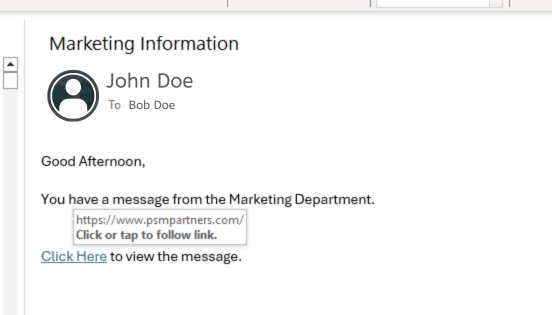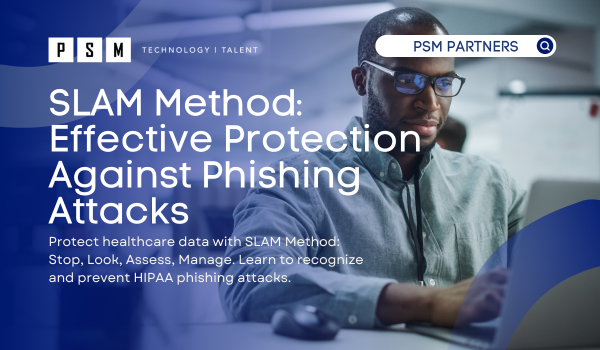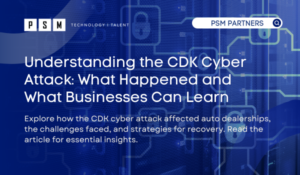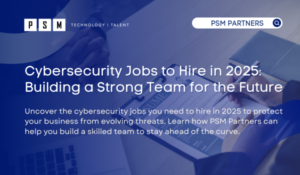Table of Contents
ToggleA primary concern for healthcare organizations revolves around the critical need to identify phishing emails effectively and thwart potential breaches. Researchers from Stanford University and a top cybersecurity organization found that approximately 88 percent of all data breaches are caused by an employee mistake. Human error is still very much the driving force behind an overwhelming majority of cybersecurity problems.
Addressing this challenge, the SLAM method offers a straightforward yet powerful solution. This method provides healthcare organizations with a practical approach to recognizing and mitigating the risks associated with phishing emails, enhancing their overall cybersecurity posture.
What Is the SLAM Method?
The SLAM method is a low-cost and common-sense approach to preventing phishing attacks, which can ultimately help maintain HIPAA compliance. HIPAA, the Health Insurance Portability and Accountability Act, plays a crucial role in healthcare organizations by establishing industry-wide standards for safeguarding sensitive patient information.
What is Email Phishing?
Email phishing refers to an internet scam wherein cybercriminals send deceptive emails that mimic legitimate sources, aiming to deceive individuals into divulging personal information like bank account numbers, passwords, or credit card details.
SLAM Method Meaning
The SLAM method is an acronym for:
- Stop, Look, Assess, and Manage, which involves double-checking the
- Sender, Link, Attachment, and Message.
Guard against phishing attacks and uphold HIPAA compliance with this catchy four-step process. Phishing attacks use deceptive emails to trick users into clicking on malicious links or downloading malicious attachments. By using the SLAM method, businesses can protect themselves from these attacks and maintain HIPAA compliance. The SLAM method stands for Stop, Look, Assess, and Manage. This method involves taking a moment to stop and assess an email before clicking any links or downloading any attachments. It is important to look for red flags such as suspicious senders or urgent requests. Once an email has been assessed, it can be managed appropriately by either deleting it or reporting it to the proper authorities.
By implementing the SLAM method, healthcare organizations can protect themselves from HIPAA phishing attacks and maintain compliance with industry standards. This method is simple and easy to implement, making it an effective tool for any organization looking to improve their cybersecurity measures.
Slam Method for Cybersecurity
The SLAM method can be applied to any email that users receive, whether it is from a coworker, a vendor, or a customer. By using the SLAM method, businesses can protect themselves from phishing attacks and maintain HIPAA compliance. The method is simple and easy to use, making it an effective tool for preventing cyber-attacks. Attackers use various tactics to trick employees into disclosing confidential information, such as login credentials, patient records, and financial data. In this section, we will discuss some common HIPAA phishing tactics and the impact they can have on healthcare organizations.
- S for Sender: Before opening an email, examine the sender’s email address. Phishers often pose as reputable entities, such as legitimate companies, bosses, or coworkers. Hover your mouse over the sender’s name to reveal the email address and check for misspellings or inconsistencies.
- Example:
- Secure: support@verizon.com
- Potentially Unsafe: support@veriizon.com, support@zerizon.net
- Example:
- L for Links: Phishing emails commonly contain links that can lead to the theft of login information. Hover over links without clicking to inspect the URL. Watch out for misspellings and inconsistencies between the link and the alleged company’s website URL. A legitimate link from a company should have the same domain as their website.
- Tip: Manually input the company’s website into your browser or contact the company/sender for confirmation if unsure about a link’s legitimacy.

- A for Attachments: Exercise caution with email attachments, especially from unknown senders. Even if you recognize the sender, confirm the legitimacy of unsolicited attachments. Reach out to the sender directly if possible. Attachments can harbor malware, ransomware, or other harmful viruses.
- Questions to ask: Does this person usually send you attachments? Does the attachment name match previous submissions? Is the attachment format consistent with previous ones? If uncertain, verify the email’s legitimacy through direct contact.
- M for Message: Pay attention to the details within suspicious emails. Generic greetings, grammatical errors, strange wording, and misspellings can be red flags. Legitimate companies often use spell-check, so errors may indicate possible fraud. The absence of a subject line can also be a sign of a phishing attempt.
When in doubt, inspect the content of suspicious emails for inconsistencies or signs of phishing attempts. The SLAM Method provides a structured approach to enhance your ability to detect and mitigate potential cybersecurity threats.
Types of Phishing Attacks and The Consequences
Phishing attacks can take many forms, but they often involve emails or messages that appear to be from a trusted source, such as a colleague or a reputable organization. Here are some common tactics used in HIPAA phishing attacks:
- Deceptive Phishing: Attackers use deceptive emails to trick users into clicking malicious links or downloading malicious attachments. These emails may appear to come from a legitimate company, such as a bank, that asks users to verify their account information or download an important document.
- Spear Phishing: This type of attack targets specific individuals within an organization, such as executives or IT staff, to gain access to sensitive information. Attackers may use information gathered from social media or other sources to personalize the message and increase the likelihood of success.
- Whaling: Like spear phishing, whaling targets high-level executives or individuals with access to sensitive information. Attackers may pose as a CEO or other top executive to trick employees into disclosing confidential data.
HIPAA phishing attacks can have a significant impact on healthcare organizations. In addition to the loss of sensitive patient data, organizations may face legal and financial consequences for violating HIPAA regulations. Here are some potential consequences of a successful HIPAA phishing attack:
- Data Breaches: A successful phishing attack can result in a data breach, which can expose sensitive patient information to unauthorized individuals. This can lead to identity theft, financial fraud, and other forms of cybercrime.
- HIPAA Violations: Healthcare organizations that fail to protect patient data can be fined by the Department of Health and Human Services (HHS) for HIPAA violations. Fines can range from $100 to $50,000 per violation, with a maximum penalty of $1.5 million per year.
- Reputation Damage: A data breach or HIPAA violation can damage an organization’s reputation and erode patient trust. This can lead to lost revenue and difficulty attracting new patients.
HIPAA phishing is a serious threat to healthcare organizations. By understanding common phishing tactics and the potential impact of a successful attack, organizations can take steps to protect themselves and their patients.
Example of the SLAM Method
Another healthcare organization trained their employees on the SLAM method. One day, an employee received an email with an attachment from an unfamiliar sender. The employee followed the SLAM method and looked closely at the email. They noticed that the attachment had an unusual file extension and did not open it. They reported the email to their IT department, who confirmed that it was a phishing attempt. The IT department was able to take action to prevent any further attempts from that source.
What to Do When You Recognize a Phishing Email
Recognizing phishing emails is crucial, and knowing how to respond is equally important. Follow these steps to effectively handle a phishing attempt:
- Mark the Email as Spam: Quickly identify the threat by marking the suspicious email as spam. This will help filter out similar emails in the future.
- Report to Management: Inform your management about the phishing attempt. This proactive step allows them to alert other employees, fostering a collective awareness.
- Notify IT Department or MSP: Take action by reporting the phishing email to your IT department or Managed Service Provider (MSP). This aids in blacklisting the sender’s domain address, enhancing overall cybersecurity.
- Exercise Caution – Do Not Forward: Resist the urge to forward phishing emails to anyone. This prevents the spread of potential threats and ensures responsible handling of the situation.
How PSM Can Help
While the SLAM Method is a valuable tool for phishing prevention, it should complement, not replace, the essential practices of adhering to cybersecurity compliance and participating in regular training sessions. In the ever-evolving landscape of cybersecurity, it’s evident that proactive measures are essential to combat the growing sophistication of cyber threats.
PSM Partners emerges as a trusted ally in this realm, offering comprehensive cybersecurity services tailored to address the latest challenges. Safeguard your business with PSM Partners, where expertise meets cutting-edge technology for a resilient and secure digital future. Choose PSM Partners and stay ahead in the dynamic world of cybersecurity.
Related Insights
Understanding the CDK Cyber Attack: What Happened and What Businesses Can Learn
Key Takeaways From the CDK Global Cyber Attack Massive DisruptionOn...
Read MoreCloud Engineer vs. Software Engineer: Understanding the Differences
In today’s rapidly evolving technology landscape, both cloud and software...
Read MoreCybersecurity Jobs to Hire in 2025: Building a Strong Team for the Future
The cybersecurity job market is evolving rapidly, driven by advancements...
Read MoreWhat Users Can Expect After The NetDocuments, Worldox Acquisition
Efficient document management is the key to the success of...
Read MoreAbout the Author

Stephen Rosendahl
With over two decades of hands-on experience in cybersecurity, both in the government and the corporate realm, Stephen’s navigated the complexities of safeguarding national secrets and driving business cybersecurity objectives. He aims to share his expertise, chronicle his experiences, and offer a unique perspective that blends military precision with corporate innovation. Join him as he delves into the intricacies of cybersecurity, unraveling its nuances and highlighting its paramount importance in today's digital age.





